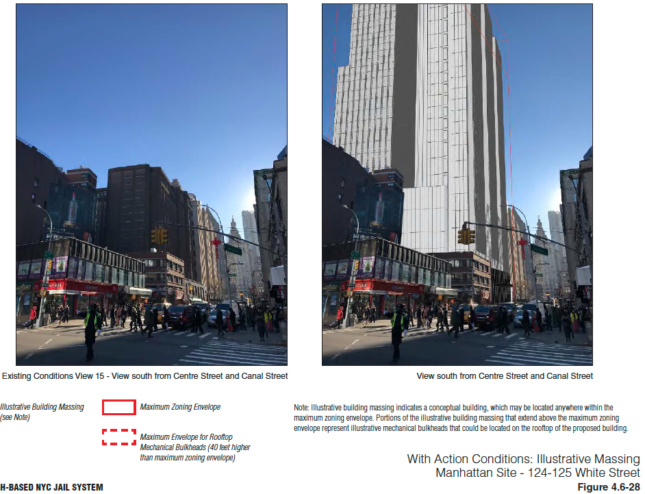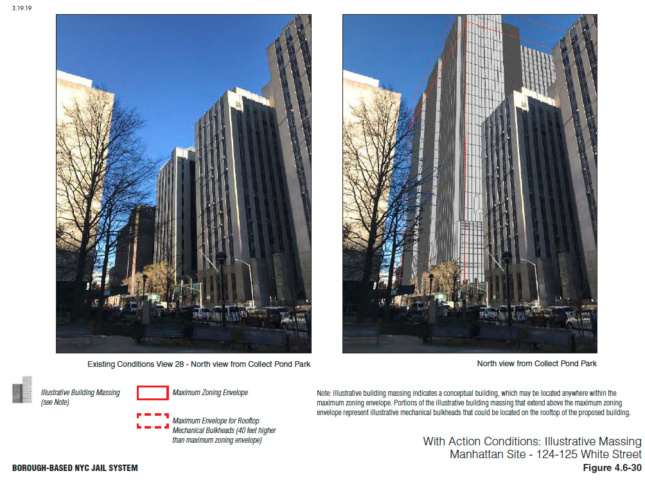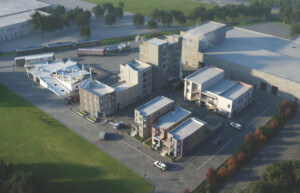The de Blasio administration’s 10-year plan to close Rikers Island and replace it with four borough-based jails is ahead of schedule, but community groups are voicing their opposition to some of the proposed replacements.
Residents of Tribeca and Chinatown are up in arms over the decision to build a 45-story jail tower at 125 White Street, currently the Manhattan Detention Complex more infamously known as “the Tombs.” While the city had originally planned to shift a portion of the island’s projected 5,000 inmates (the administration expects to reach that number from the current 9,000 through bail and sentencing reform) to a 40-story tower at 80 Centre Street in Lower Manhattan, that fell through in November of 2018.
Now, the plan is to demolish the two towers at 124 White Street (13 stories) and 125 White Street (9 stories) and replace them with a 45-story, 1.27-million-square-foot tower with 1,440 beds.

The entire Rikers replacement plan is currently moving through the Uniform Land Use Review Process (ULURP), and thanks to a $7.7 billion bonus to the Department of Corrections (DOC) in the 2020 capital plan, is expected to wrap up in 2026, a year ahead of schedule. But as part of the ULURP, each of the four borough-based jails are currently facing public feedback as part of the environmental and land use review.
Tempers have flared at Community Board 1’s meetings over the 125 White Street tower. At an April 8 meeting before the board’s Land Use, Zoning and Economic Development Committee, residents clashed with social justice activists.
Because the proposed tower would be 37 percent larger than what the area’s zoning allows, the jail requires a permit from the City Planning Commission before it can proceed, of which public feedback is taken into consideration.
Overall, a number of Tribeca, Chinatown, and SoHo residents raised concerns over the cost (the new jails will require $11 billion to complete); the shadows cast by the tower, which would stretch from West Broadway to Mott Street in the winter and from Church Street to Chrystie Street in the summer, according to the Draft Environmental Impact Statement (DEIS); the impact of the Tombs demolition on the surrounding neighborhood; and the potential repurposing of the proposed tower into luxury housing if the city manages to decrease the number of incarcerated peoples enough. While that last concern may seem a tad outlandish, the original proposal for the tower at 80 Centre Street did involve a mix of affordable housing units.

Architect Alice Blank, who sits on Community Board 1, also raised concerns about the potential history that would be lost if the Tombs came down. Blank pointed out a resolution recently passed by Community Board 3 against the demolition, which states:
“The Art Deco/Art Moderne-styled South Tower of the current Manhattan Detention Center is NYC Landmark eligible, and the Manhattan Criminal Courts Building and Prison at 100 Centre Street have previously been determined to be New York State National Registry-eligible. These eligibilities suggest that the proposed demolition and redevelopment would be an inappropriate and significant loss of historic and architectural resources. The 100 Centre Street building, which retains some Egyptian Revival architectural details from the original ‘Tombs’ building, as well as 80 Centre Street and 125 Worth Street constitute a coherent architectural group in Civic Center. The demolition of ‘the Tombs’ would undermine the value of a visible piece of the criminal justice history and the historical development of NYC.”
Of course, criminal justice and prison reform advocates have pushed back. In 2017, Rikers was appraised as being so dangerous by the State Commission of Correction that the agency halted transfers of inmates into the jail from outside of the city. At the time, the oversight commission found that Rikers failed to meet minimum safety standards.
The Tombs has its own well-documented legacy of violence, and the building’s squalid conditions aren’t helped by the tiny slit windows punched into its monolithic facade.

At the April 8 meeting, it was clear that pro-jail tower activists saw the issue as a racial one, while opponents of building a jail tower in Manhattan have argued that renovating Rikers Island would only cost $1 billion and would mitigate all of their concerns.
“I’m disgusted to hear that y’all don’t even want to have a new jail when 90 percent of the people who are incarcerated in the Department of Corrections are black and brown Latin people. Not any of you that are opposing this tonight!” a woman shouted at the CB1 meeting, according to The Tribeca Trib.
“Having jails on Rikers Island doesn’t solve half of our problem,” said a spokesperson from the Mayor’s Office, who offered to comment after AN queried the DOC. “Renovating Rikers wouldn’t do it. The facilities are too archaic and old, and they don’t have the appropriate space or programming. To say that Rikers can be rehabilitated is untrue.”
Centralizing the jail population on an island mainly accessible via the Rikers Island Bridge adds an extra level of undue hardship to the jail’s staff, visitors, and inmates who have to meet court dates in their home boroughs—each jail tower has been proposed for a site close to the borough’s courts. It also damages inmates’ connections to their local support networks, added the spokesperson.
Building new facilities will allow the city to not only increase the cell size for each inmate and better the light and air conditions, but to add vocational, health, educational, and re-entry programs to each location.
When asked whether the city could convert the Manhattan jail tower into market-rate housing down the line, however, the spokesperson was unable to rule it out. They said that it was too early to draw any conclusions about where the prison population would be ten years down the line, especially before the bulk of Mayor de Blasio’s bail reform proposals took effect.
Time will tell whether the city alters its Manhattan tower proposal before appealing to the City Planning Commission. The Manhattan Community Board 1 Land Use Committee will be voting on a recommendation for the Borough Based Jails/Manhattan Detention Complex ULURP application on May 13. A full board vote will come later in May, followed by a public hearing held by Manhattan Borough President Gale Brewer. After that, the scheme will be voted on by the City Planning Commission, and finally, the City Council.
It should be noted that all of the preliminary massings released thus far have been just that, and no concrete design details have been made public yet.
Update: An earlier version of this article stated that Rikers Island was reachable by ferry, which is incorrect. While plans to connect the island to the NYC ferry system have been proposed, it is not a stop at the time of writing.











